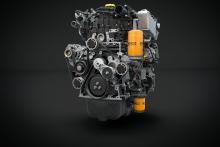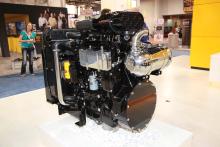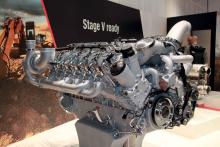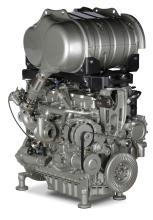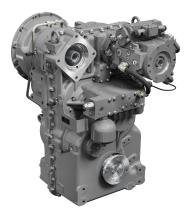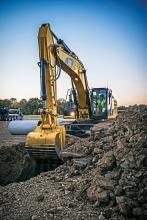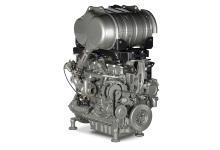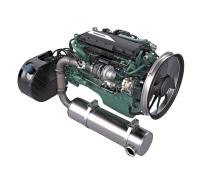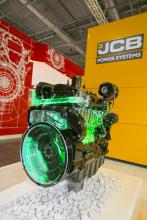
R&D in the quarrying and construction equipment engine sectors has entered a fascinating period, a period that could lead to important performance gains for machine buyers and renters. Dan Gilkes reports.
Exhaust emissions have been the biggest driver in engine development for many years. Engineering teams have been so consumed with reducing emissions, that they have hardly had a chance to look further than the engine bay or the cooling pack. Now finally, with only EU Stage V emission regulations on the horizon in 2019-20, there seems to be some light at the end of the tunnel. Manufacturers will be able to divert some of their research and development spend into other components and systems, many of which will no doubt prove to be equally important in terms of productivity and efficiency.
Many engine manufacturers have announced that they can already meet the expected regulations. The main difference between Stage IV and Stage V is the fact that soot particles will be counted as well as weighed, producing a Particulate Number (PN) alongside the existing Particulate Matter (PM) and NOx figures.
It is thought that the only way to limit the number of particles to a number that will meet the standard, will be through the use of a Diesel Particulate Filter (DPF). However, manufacturers seem to be viewing the change very much as an evolution of current technology, rather than a revolution that will cause radical machine redesigns.
The other big change with Stage V, will be that the regulation will apply to a much wider power band of engines. This will include compression ignition engines below 19kW and all engines above 560kW, which were previously excluded from the latest standards.
Though Stage V will not affect the US market directly, most manufacturers will build engines that meet both US Tier 4 Final and the European Stage V standard.
Announced last year, the F3.8, B4.5, B6.7 and L9 engine ranges are said to offer up to 10% more power and 20% more torque than their Stage IV equivalents. Rather than increasing capacity or boosting exhaust aftercare, this has been achieved by concentrating on combustion, air flow and fuel injection systems.
All of these engines will be supplied with the firm’s Single Module exhaust after-treatment package. This is said to be up to 50% smaller and 30% lighter than a multi-box Stage IV/Tier 4 Final solution. This is particularly important for equipment manufacturers, who need to be able to adopt the new standard without having to redesign the engine bay or cooling pack compartment.
Cummins’ larger X12 and X15 engines, offering up to 376kW and 496kW respectively, will continue to use the Diesel Particulate Filter and Selective Catalytic Reduction (DPF-SCR) aftertreatment system currently in use on the firm’s Stage IV engines.
Volvo has recently opened a driveline test facility at its head office site in Sweden. Capable of controlling each wheel independently, the test rigs will allow Volvo to continue to investigate autonomous drive, battery-electric drive and hybrid machines, such as the HX2 load carrier and the LX1 hybrid wheeled loader. This focus on alternative driveline technology demonstrates that emissions standards are not the only focus for equipment manufacturers.
While showing how it will meet Stage V earlier this year,
The
FPT claims that the V20 range will meet Tier 4 Final and Stage V emissions standards without the need for a cooled EGR system. The engines feature a new piston bowl design and combustion chamber and the latest generation common rail fuel injection systems, with fuel rails on each bank of the engine’s vee.
US manufacturer
Deere is moving the gear train from the front of the engine to the rear of the block, reducing noise levels and boosting block rigidity. The engines will also offer the potential for two power-take-off drives for ancillaries, along with a full power transfer from the nose of the crankshaft, something that was not available on the previous engine. The 13.6litre motors will have a cooled EGR module bolted onto the cylinder block and the company is claiming a 20% reduction in maintenance costs should be possible.
Deere has also redesigned its emissions control modules, adopting the increasingly popular single-can solution that brings together Diesel Oxidation Catalyst (DOC), DPF and SCR in a single canister. This results in up to a 30% space saving for the exhaust system, which should prove popular with machinery designers.
As engines have adopted increasingly sophisticated electronic control systems, manufacturers have been able to incorporate engine information into telematic data. This allows operators to remotely check the condition of engines and other driveline components, analysing fuel consumption, machine use and other factors that should boost productivity.
Telematics also improve diagnostic capability, reducing downtime and increasing availability for the end user. Accessing engine data need not be a complex process either. Cummins has launched a user-friendly engine data analytic app for off-highway use. The Cummins Guidanz app enables remote monitoring of any of the firm’s Tier 3 or later engines, providing instant reading of fault codes. This makes it easier for service technicians to provide a first-time fix to any fault on site.
The app, which works with Apple and Android platforms, requires a Bluetooth adapter that is plugged into the engine’s electronic control module (ECM). Any recorded fault code is automatically reported to the app, which provides service centre locations and allows customers to connect directly with Cummins Care to book the repair.
The Perkins division of Caterpillar has also produced an app for Apple and Android devices, allowing users to access build data, service and parts manuals and to find service parts. Perkins My Engine also provides a way for customers to manually log engine hours, to predict service schedules and to provide a list of service parts and criteria for a particular engine.
Taking it a stage further, Perkins is set to introduce an electronic oil cap that can be installed on anything from a compact 0307 engine right up to the 1206 series. The cap monitors engine operating hours through vibration frequencies, feeding data to the Perkins My Engine app when the user is within Bluetooth range.
While it is doubtful that every operative on site is going to be monitoring the equipment around them on their smartphones, advances in information technology and connectivity look set to be the next big step in construction and mining machinery development.
With fleet managers, dealers and manufacturers having access to an increasing amount of operating data, whether through localised apps or from global telematic tracking, equipment will become more efficient, more productive and less polluting. As the focus finally moves away from purely concentrating R&D budgets on engine emissions, this could be a very interesting time to be operating construction and mining machinery.

